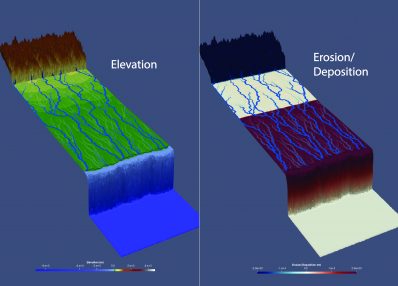Understanding History Through Sediment Patterns
November 12, 2020

Forces that shape the Earth’s surface are recorded in a number of natural records, from tree rings to cave formations. In a recent study, researchers at the Bureau of Economic Geology show that another natural record — sediments packed together at basin margins — offers scientists a powerful tool for understanding the forces that shaped the planet over millions of years. The study, published in the journal Geology, uses a computer model to connect distinct patterns in the sedimentary deposits to shifts in climate and tectonic activity.
“We are trying to find a way to distinguish the tectonics and the climate signals,” said lead author Jinyu Zhang, a research associate at the bureau. “By using this numerical model, we suddenly have this power to simulate the world under different tectonics and climate.” Zolt.n Sylvester and Jacob Covault, both research scientists at the bureau, co-authored the paper.
Geoscientists have long looked to sedimentary basins for clues about Earth’s past climate. That’s because sediment supply is closely linked to environmental factors, such as rainfall or snowfall, that influence sediment creation through erosion and sediment transport. Tectonic factors also influence sediment creation, with increasing uplift associated with more sediment and decreasing uplift with less.
However, despite knowledge of sediment supply being linked with climate and tectonics, the researchers said little is known about how changes in these phenomena directly influence how sediment is deposited along basin margins over long time scales.
This study changes that, with Zhang using the open-source computer program pyBadlands to create a “source-to-sink” 3D model that tracks how changes in precipitation, tectonic uplift and sea level influence sediment erosion and deposition. The model uses topography inspired by the Himalaya Mountains and Indus River Delta to track sediment as it makes its way from the mountains through a river system and into a basin margin over millions of years.
“This is one of the first [models] to put the landscape evolution part with the stratigraphic response, depositional response, and do it in 3D,” Covault said. “Jinyu has made a really great step in putting this all together.”
Back to the Newsletter